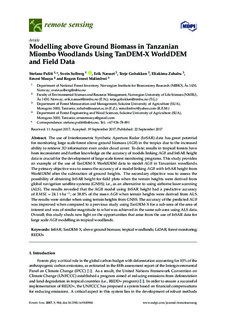| dc.contributor.author | Puliti, Stefano | |
| dc.contributor.author | Solberg, Svein | |
| dc.contributor.author | Næsset, Erik | |
| dc.contributor.author | Gobakken, Terje | |
| dc.contributor.author | Zahabu, Eliakimu | |
| dc.contributor.author | Mauya, Ernest William | |
| dc.contributor.author | Malimbwi, Rogers Ernest | |
| dc.date.accessioned | 2018-06-29T08:20:16Z | |
| dc.date.available | 2018-06-29T08:20:16Z | |
| dc.date.created | 2018-01-11T11:25:03Z | |
| dc.date.issued | 2017 | |
| dc.identifier.citation | Remote Sensing. 2017, 9 (10), . | nb_NO |
| dc.identifier.issn | 2072-4292 | |
| dc.identifier.uri | http://hdl.handle.net/11250/2503720 | |
| dc.description.abstract | The use of Interferometric Synthetic Aperture Radar (InSAR) data has great potential for monitoring large scale forest above ground biomass (AGB) in the tropics due to the increased ability to retrieve 3D information even under cloud cover. To date; results in tropical forests have been inconsistent and further knowledge on the accuracy of models linking AGB and InSAR height data is crucial for the development of large scale forest monitoring programs. This study provides an example of the use of TanDEM-X WorldDEM data to model AGB in Tanzanian woodlands. The primary objective was to assess the accuracy of a model linking AGB with InSAR height from WorldDEM after the subtraction of ground heights. The secondary objective was to assess the possibility of obtaining InSAR height for field plots when the terrain heights were derived from global navigation satellite systems (GNSS); i.e., as an alternative to using airborne laser scanning (ALS). The results revealed that the AGB model using InSAR height had a predictive accuracy of RMSE = 24.1 t·ha−1 ; or 38.8% of the mean AGB when terrain heights were derived from ALS. The results were similar when using terrain heights from GNSS. The accuracy of the predicted AGB was improved when compared to a previous study using TanDEM-X for a sub-area of the area of interest and was of similar magnitude to what was achieved in the same sub-area using ALS data. Overall; this study sheds new light on the opportunities that arise from the use of InSAR data for large scale AGB modelling in tropical woodlands. | |
| dc.description.abstract | Modelling above ground biomass in Tanzanian miombo woodlands using TanDEM-X WorldDEM and field data | |
| dc.language.iso | eng | nb_NO |
| dc.rights | Attribution-NonCommercial-NoDerivatives 4.0 Internasjonal | * |
| dc.rights.uri | http://creativecommons.org/licenses/by-nc-nd/4.0/deed.no | * |
| dc.title | Modelling above ground biomass in Tanzanian miombo woodlands using TanDEM-X WorldDEM and field data | nb_NO |
| dc.title.alternative | Modelling above ground biomass in Tanzanian miombo woodlands using TanDEM-X WorldDEM and field data | nb_NO |
| dc.type | Journal article | nb_NO |
| dc.type | Peer reviewed | nb_NO |
| dc.description.version | publishedVersion | |
| dc.source.pagenumber | 13 | nb_NO |
| dc.source.volume | 9 | nb_NO |
| dc.source.journal | Remote Sensing | nb_NO |
| dc.source.issue | 10 | nb_NO |
| dc.identifier.doi | 10.3390/rs9100984 | |
| dc.identifier.cristin | 1540645 | |
| cristin.unitcode | 192,14,0,0 | |
| cristin.unitname | Miljøvitenskap og naturforvaltning | |
| cristin.ispublished | true | |
| cristin.fulltext | original | |
| cristin.qualitycode | 1 | |

